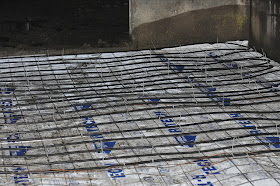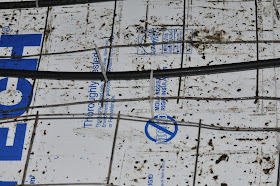Last week or so I've been working on the completion of my little barn. I like working with concrete as a material -- pourable stone, what's not to like? -- but this particular little slab has been pretty complicated.
The picture above is a cut-away view of a a typical foundation. The green circle is a drain tile (a pipe laid along the edge of a foundation to allow water to drain). The horizontal part that the pipe is laying on is the footing, and the vertical part is the knee wall. Concrete, as materials go, is relatively expensive. Your knee walls are usually as short as you can make them -- it's cheaper to build a wall with wood -- but in this case I'm choosing to make the knee walls relatively high; part of that is that having someone else do concrete for you is expensive -- but the costs go way down if you can do it yourself. The slab is inside the knee wall, on top of a bed of gravel.
I prefer to lay slabs on gravel beds because gravel is cheaper than concrete. let's rephrase that; to get a slab to a particular level, you can either bring the ground up or bring the slab up -- pour more expensive concrete, make a thicker slab. In this case, $150 worth of gravel saves $500 worth of concrete. I work the gravel with an 8' 2x6 and a rake, smoothing it as I go. I moved the gravel into the building and spread it with my tractor.
The next step is to lay down plastic -- I'm concerned about water under this slab. The plastic keeps the concrete from penetrating the gravel, and allows the gravel to act as a drain, allowing the water to move under the slab. If the ground was relatively dry you can skip this step, but for the $30 that a sheet of plastic costs, I do this under every slab as extra protection.
One of the ideas I'm working with is a radiant heating system in the floor. To do this you need to make sure that the slab of concrete that is your floor is thermally isolated from the ground. So on top of the ground there's a layer of gravel, then 2" foam insulation boards, then 6x6 concrete reinforcing mesh and on top of that is the tubing will be used to heat the slab.
The reinforcing mesh will make the slab resist cracking and settling, and is just what you need to tie the pipe in. Here I'm using zip-ties. they won't damage the tube in the future.
The reason I'm choosing to do this is that this area will be a working area, and will contain pig equipment and gear, as well as water supplies for pigs housed here.
So here's the basic theory on radiant floors: The concrete slab will be heated by liquid run through the tube; this heat will radiate up from the slab, providing an even, pleasant heat without hotspots, or the need for radiators or other ductwork. Since I'll be using this space as a barn, and scraping it out with a tractor, having a smooth, impervious floor and clear space is a big plus. Now I don't have to use the heating ability of the floor at all -- if I choose not to, I've spent $200 or so in vain. But short of ripping it up and messing with it, when you pour the slab is when you do this, so I'm putting it in now to keep my options open in the future.
For a low-temperature barn -- say 50 to 60 degrees -- you can use a small water heater, a pump, and a low-temperature thermostat to keep your building comfortable. The water heater is on at all times; when the thermostat detects low temperatures, it starts the pump, which continues until a pre-set temperature is reached. the water heather, pump and floor are on a closed system, which if I do this will be filled with a non-toxic mix of water and antifreeze. (I don't want to have to worry about the liquid freezing in the heating system, and I don't want to have issues with animals drinking toxic antifreeze. )
A second option is to mount a solar collector on the roof. Have a pump switch on when the water in the collector hits 100 degrees (which you can get to even on a cloudy day). While the pump is running it's circulating the water water through the slab, transferring solar heat into the mass of the slab. After dark the pump switches off and the slab then releases its heat gathered during the day overnight. The next morning the process repeats.
This is basically the same thing that a heat pump does, but I can't bring myself to pay thousands for a heat pump. A little 12 volt pump, a few solar cells, a couple of temperature sensors and some copper pipe and lumber makes a perfectly workable system that costs a few cents a day to operate.
What's all this cost? The insulation is actually the most expensive; it's $15 per 4x8 sheet of 2" material. it's R7 or so, which works for my purposes. the reinforcing mesh and gravel I would have done with any slab. The tubing is $0.60/foot, and to do a 20x20 with tubing at 8-9" centers took about 320' of tubing and a coupling. You'll want a pressure gauge and cap to test your system to make sure its airtight before you pour; that costs about $20.
Total cost to put in radiant floor heat option: about $1.20/square foot.
For a discussion of pressure testing the floor plumbing and a discussion of the types of tubing used, check here.







It sounds like you'll have a nice barn when it's done. Thanks for taking the time to explain the radiant floor heating system. It doesn't sound all that complicated and I may put one in when I build my shop. Keep up the good work. Your blog is great!
ReplyDeleteSounds cozy!! I keep telling my hubby, buy me land, build me a barn, I will be happy to live in it 'til the house is built. If my feet are warm, I'm good!!
ReplyDeleteWe had to winterise our Washington home this fall because I had to go back East for the last time. I used an RV antifreeze which is safe for pets and safe for septics also. Two of the things I was worried about. My BIL installs radiant heat (geothermal ) as his career. He says they use a non toxic fluid in it but I like the antifreeze idea better. We are planning on radiant heat for our house in Washington when we build. We are also thinking geothermal but we will see.
ReplyDeleteAdele
I never would have thought of a radiant-floor-heated barn, but it keeps flexibility.
ReplyDeleteI do like reading these 'source code' postings, similar to the corral ones.
The skimpy radiant floor attachment method you did is going to come back to haunt you later. You shouldn't have attached the wire and tubing like that. Reeeelllllllly bad ideah.
ReplyDeleteI'm open to your thoughts on that. Can you expand on that -- and maybe mention what you've used to connect it in the past?
ReplyDeleteYou have to attach it in some way, and after talking to several different contractors, nylon tie-wraps was the preferred. They're softer than the tubing, so can't cut it, and provide a secure attachment until the pour -- and after the pour the concrete will hold the tube in place.
But I'm always open to other ideas.
slab must be carefully done.
ReplyDeletebasement waterproofing Milwaukee
I checked The Radiant Floor Company, a radiant floor supplier. Their installation guide says to zip tie to the reinforcing mesh. Page 18, top left. http://www.radiantcompany.com/manual/Manual-Edition8.pdf
ReplyDeleteI too would be interested in hearing reasoning not to and other alternatives.
Not the same Anonymous
Good post very interesting.
ReplyDeleteI agree with this solar radiant flor heat, slab must be carefully done.
ReplyDeleteFloor Warming